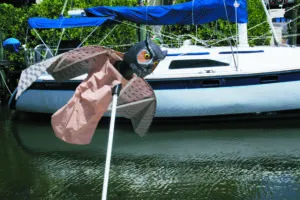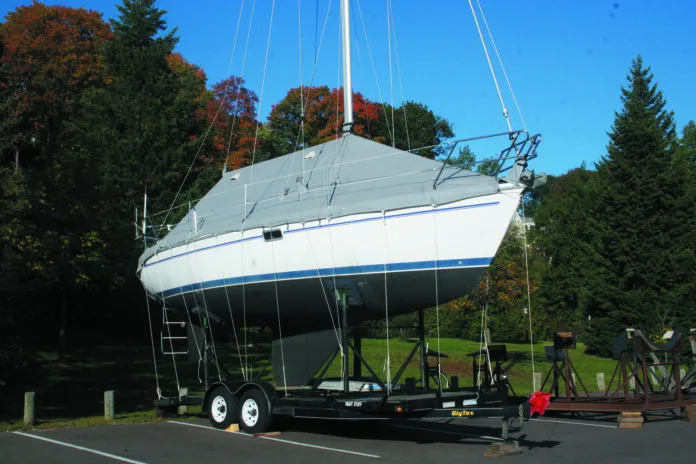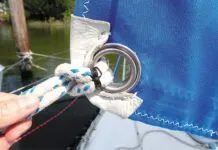IN PRAISE OF KOVER KLAMPS
Thanks for this great article on winter covers (see Inside PS blog, “What to Look for in a Winter Cover”), I wrestled with this decision after buying my first sailboat in the summer of 2020. I realized that I had to make a decision as winter approached and some leaky deck problems caused me to want to dry the boat out. I decided I wanted a full cover that would transmit some light and allow me to work underneath all winter. I chose a system from Kover Klamps. I have not seen them mentioned in your articles. It is based on metal electrical conduit (EMT) and connectors. All told, it cost about $1,600 for the frame and a tarp to go over it with a zip door, tie downs, and spares. I expect to get two or three years out of the tarp, and decades from the metal frame. It took a good bit of time to build the first time, and is not easy to move. But it is nice to work under during the winter, and allowed me to replace my two fixed and four opening portlights last winter. This year, I will probably repair a piece of broken deck under a stanchion, and re-bed all of the other stanchions. In all, it has allowed me to work in relative comfort. It costs less than shrinkwrap and has less plastic waste. It costs and weighs less than canvas, and allows solar heating and lighting. I worry that it causes a lot of wind resistance due to how high I made it. It is scary to work under when the wind exceeds 25 knots!
Sean McClain
O’Day 28
Fair Haven, NY

cover and frame-kit supplied by Kover Klamps.
TOP FLIGHT COVER
We have a 2001 Catalina 42 which came with Top Flight cover. We replaced the cover with a new one from Top Flight, and had additions for storing with the mast up. We modified the rear to accommodate our new Tower in a Box, which required four new zippers and flaps to wrap around the tower.
We have 17 seasons from the first cover, and the new one going on three. Beats having to buy plastic shrink wrap every year, and filling up our waste dumps with all that plastic, and at less expense. And Top Flight is very responsive when you need parts (new conduit or brackets) or to modify the existing cover for new things.
Douglas Howe
via Practical-sailor.com
HOSE TIPS FOR COOLING HOSE
Regarding your hose advice (see “Hose Fitting Tips,” PS May 2016), I have switched to silicon radiator hose for water or coolant hoses that need to be easily removed. I’ve had no problems with years of use. Be sure to use a smooth hose clamp to prevent cutting into the hose. If the engine hasn’t been used in a long time I remove the hose to the raw water pump and add a little soapy water to prime and lubricate it to extend the life of the impeller. It is very easy with the silicon hose.
When I need to remove a vinyl hose, to heat all around the fitting without overheating one side or the stuff around it, I wrap a strip of towel around the connection and soak it in hot water. I refresh the hot water several times and it softens the hose without overheating.
Joseph Huberman
Wylie 43 Prestissimo
Raleigh, NC
When going this route use only silicone hoses approved for marine use and confirm with the manufacturer that it is designed for your intended purpose. Soft automotive hoses can collapse under suction. Any belowwaterline raw water hoses should be reinforced to resist collapse and be designated “suitable for below the waterline or raw water use.”
SENSIBLE DOWNSIZING
Thank you for summing up my feelings about downsizing (see “Downsizer’s Dream” PS February 2020). We have had several wonderful cruising boats, all in the 30-foot size and really enjoyed them, but used them less each year. Now I have the smallest boat in the marina (17-foot Cornish Crabber) and enjoy it for all the reasons you mention. My neighbors, in their multi hundred thousand dollar power boats, also tell me that more people stop to look at my boat than any other on the marina, especially theirs! Any size sailing boat gives pleasure, but the great thing about sailing is that a wonderful daysail in a small seaworthy boat can be as memorable as any other type of sailing. I don’t trailer sail as I only live 4 minutes from the marina, so can be underway in less than 10 minutes from leaving home
Martin Model
via Practical-sailor.com
BEDDING STAINLESS
With regards to your test of marine adhesive sealants (see “Marine Sealant Adhesion Tests,” PS December 2016), I, also, have found on numerous occasions that over time 5200 doesn’t bond well to stainless steel. While you point out that 5200 “does not bond to stainless steel as well as some other products,” it would have been better if you had somewhere indicated which of those others your were referring too does bond well, instead of leaving us dangling. I say this as I re-bed my chainplates, to which 5200 has not adhered well.
Steve Wolfe
via Practical-sailor.com
There are several options for stainless steel depending on the application, including: Sikaflex 291, Sikaflex LOT 291, Loctite PL S40, silicone-based sealants, and butyl tape. (Search the online archives for “adhesive sealants”.) Often adhesion problems with stainless-steel are due to surface contamination.

became accustomed to spooky fake owls and
snakes.
BIRD DETERRENTS
Thanks for your tips on how to deter birds from your dock. My father just bought a boat and is planning to get a dock construction company to build a dock near our lake house. Since I expect he’ll be telling me to clean up his dock whenever birds poop on it like he makes me do with his boat, I thought it’d be a good idea to look up how to repel them instead. I’m a big fan of simply adding spikes to the spots where birds choose to hang out. That sounds simple enough for me to do myself, and once the dock gets built I’ll have to try building that on my own.
Tammie Houston
via Practical-sailor.com
With winter upon us, and boats sitting on the hard in many places, it’s a good time to troubleshoot or update systems, and to make a to-do list for the off-season and pre-season.
STAY UP TO DATE
It’s never a bad time to update the software for your onboard electronics, but before you do, be sure to read the “Pain-free Marine Electronics Update” blog post (Inside Practical Sailor, March 31, 2015), as well as the May 2015 article, “Playing with Cards,” an extensive look at which digital-media storage cards are compatible with various marine electronics.
DRY STORAGE
Looking for ways to keep your cabin dry during off-season storage, and to prevent that musty, mildew smell? There are a number of de-humidifying methods and products available, but good ventilation is the most effective. Other options include electric dehumidifiers (PS June 2013) and absorbent chemicals, or desiccants (PS November 2012). Testers evaluated anti-mildew protectants in the November 2013 issue and mold-inhibiting products in June 2010, as well as commercial mold-cleaning products in the January 2009 issue.

BOAT STINK
If you’re battling boat stink of the holding-tank variety, be sure to read our tips for stopping stink in the May 21, 2015 blog post, along with the many sanitation system product tests we’ve done in recent years. The December 2013 issue offers a 30-month update on sanitation hose and holding-tank vent filter tests; we reviewed holding tank treatments in the February 2012 issue; and offered advice on cleaning holding tanks in the November 2015 PS Advisor. You’ll find some of these articles and other useful info in our Marine Sanitation ebook series, which is available at www.practical-sailor.com/books.
GIFT SHOPPING
Last minute holiday shopping is easy at PS online. Be sure to browse through our past Chandlery articles, which highlight new and innovative sailing gear. If you’re short on time, check out our online bookstore, www.practical-sailor.com/products, where you can select from the dozens of sailing resources that PS editors recommend, as well as Practical Sailor’s ebooks and subscription products.
Six years ago (“Marine Sealant Adhesion Tests,” published November 2016) Practical Sailor began exposing samples of marine sealants to weather and sunlight to compare how they retained adhesion and flexibility, and how well they resisted mildew. Periodically and at the end of five years, we examined the samples and awarded final grades. Near the end, we tested removing mildew with a deck cleaner and dilute bleach. Eventually, we took the sample panels down, but we didn’t throw them away. We put them in a storage area, in case we needed to refer back to them.
Recently, we’ve received reader reports that 3M 4000UV used to bed hardware had become sticky and begun to leak. We went back to our sample rack, and sure enough, the 4000UV had lost all strength, the surface had become slightly sticky, and the center had become liquid, with the same gooey feel it had the fresh out of the tube. It was a complete failure and a mess. It was a shocking change from less than a year before. It was as though the polymer had suddenly unzipped and returned to its uncured state.
The rest of the samples on the rack were performing exactly as we left them a year ago, just one year stiffer, as expected. The other polyether, Loctite Marine, was unchanged.
The response from 3M was as follows:
“Thank you for your inquiry regarding 3M™ Marine Adhesive Sealant 4000 UV, Black. We are sorry that the product did not meet your expectations. At 3M, we aim to continuously improve our products. Your feedback indicates that you have product that is prior to our reformulation in late 2018. We appreciate your interest in the product and are happy to send you a sample of the reformulated product.”
We’ve asked for a sample and will be re-testing it alongside competing products. But we won’t know anything definitive for five years. Meanwhile, we’re not going to be using 3M 4000 UV. Inspect projects where you used it, specifically anything pre- 2018. Until we know more, we’re recommending Sika 291 as the Best Choice for all-around sealing of fiberglass and hardware, and Loctite PLS40 Door and Window as our Budget Buy. We’ve been using these for decades and they’ve never let us down.
We are currently following up with 3M to get more details regarding this failure. We’d like to hear from anyone else who has had a similar experience with 3M 4000UV or any adhesive sealant. You can email us at practicalsailor@belvoir.com




































